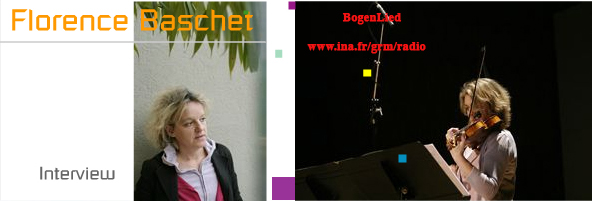
I- Introduction
Interactivity and mixed-music.
Over the last few years, my activity as a composer has concentrated on instrumental or vocal works with electro acoustic systems using real time applications. As a matter of fact, I am particularly interested in those musical fields that depend on the interactivity between a musician performing and the resulting electro acoustic issues. This approach implies three successive motivations: - to associate the intention that underlines composing for instruments, with that underlying composing for the electro acoustic sound material, with the perspective to create at term, a mutation in musical language conception. - to center such a musical association - usually called mixed-music - on the performer, (i.e. his interpretation qualities, in the very time he is playing and in the specific place he is performing), in order to bring out all the importance of this lively, singular, fragile and particular moment. - Finally, and especially with the performance of BogenLied, to try to create mixed sound spaces that unite the soloist and the electro acoustic systems into a unique interactive, reactive and sensible relationship, as it is usually the case for a chamber music relationship which unites two musicians, the two parts being in this case the soloist and the computer.
II- Instrumental gesture
Compositional preoccupations.
In our traditional musical culture, we always write strings notation with bow strokes indications as ponticello, staccato, martellato, etc. Thus, bow gesture is a significant compositional parameter. In order to be more precise, I would assert that the gestural phrasing of bowings is the expression of the instrumental thought for strings instruments, especially because such phrasing is the tool that elaborates the sound, that shapes the timbre of the sounding object with the energy, celerity and position qualities of the bow on the strings. All those qualities the bow is transmitting to the string create those numerous timbre variations. With BogenLied, my concern as a composer is to place my hearing and my compositional intention in that reserved spot of the bow strokes, to capture the gestural phrasing of the instrumentalist (In the upper violon case, a microchip fixed on the bow frog, transmits all the gesture accelerations data to the Max/MSP program on the computer) and to create with these data a new type of interactive system between the soloist and the computer. The basis of this new system is the bowings controlling the electronic audio processes and defining the synthesis parameters of the sound. From research group’s work to concert performance. In 2004, Ircam organized several research groups working on specific musical issues. These research groups intended to create a perspective of new technologies in association to new compositional challenges. Therefore, composers as well as scientists participated in these working groups. I worked as a composer in the Instrumental Gesture group and then wrote BogenLied. Our working process from research group to concert performance was genuinely fruitful. Let me outline two salient features:
- It seemed very important for me scientists who worked on these new technologies were fully associated and implicated in concert performance with real-time experience, violinist’s rehearsals, public concert time, etc.), exactly as I have been concerned with the analysis and investigation works in the research department. - The iterative process between research and composition generated fruitful feedbacks: e.g. from the analysis database collected by the scientists, I started to develop a musical form whose processes imposed for compositional reasons generated expectations not yet resolved in research and development. And this is just to name a few such benefits.
III BogenLied for upper violin and electro acoustic systems
Database
The research group built an excellent database collecting gesture analysis by recording performing violinists. The gesture analysis was related to three standard types of bow strokes, namely détaché, martelé and spiccato. Before starting to compose BogenLied for upper violin, I had to translate the graphic representation of the database into musical material to compose (figure 1).
As a composer, I concentrated first on individuating this three classes of gesture recognition in relation to the three types of bow strokes. Furthermore, within each separate class, I was led to differentiate the constitutive points of a same class by their graduate gesture variations (e.g. the variation between a big and a small détaché). Finally, I tried to hear a point external to the three classes that would be a hybrid point, analyzed and recognized by its constituent percentages such as a 50% martelé, 30% spiccato and 20% détaché.
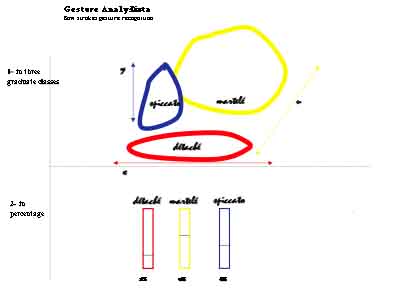
BogenLied form.
The musical form of BogenLied is a simple linear form divided into 9 sections, alternatively with and without electro acoustic systems (figure 2). In parts II, IV and VI, I focused my writing for the violin on a specific articulation of the bow stroke, associated to a specific compositional material. The gesture recognition program analyzes gesture quality, and particularly the energy rate within the articulation (which is not identical to its dynamics since a violinist can play piano with a lot of energy). These energy data are controlling the digital audio processes such as the granular synthesis of the violin sound synthesized in real time. In part VIII, the three bowings appear successively, together with their own compositional material and related electro acoustic treatment. The related electro-acoiustic treatment is driven by recognition system. At the end of the score (part IX), the performer plays hybrid bow strokes as a mutation from an articulation to another one. The system uses then the computed weights for each bowstroke to control the electronic treatment.
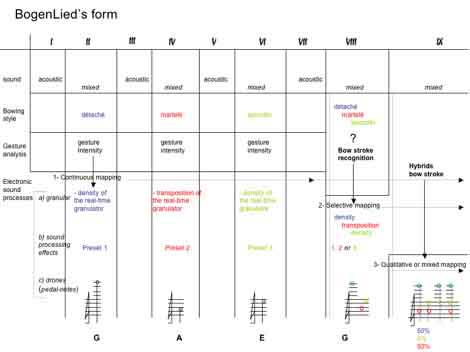
Musical notation, example score part II
In this détaché part (figure 3), I indicated at the top of the score that the violinist is «free to execute from big to small détaché» as a means to associate the performer to the interactive relationship and to the real time experience. However, the written compositional material lets me keep control of the violinist gesture. Let me give a simple example: in the fourth system in 10/4 of the score, compare the beginning and the end of the system. The beginning is a very slow shape on two strings with glissando. The gesture of the performer cannot produce much energy while playing these 8 bits. Conversely, the end of the same system is written in semiquaver with movements and changements in the tessitura, on two strings and in quarter tones. Such a shape requires many bow strokes and the gesture will be energetic, with the variations generating ample information. The data on energy rate is related to a granular synthesis variable (in the present case of détaché, a great energy of the bow stroke is related to a great density of synthesis grains).
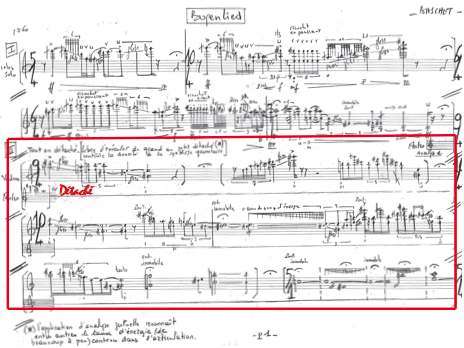
IV Electro acoustic systems
Real-time configuration
The diagram (figure 4) shows the real time configuration at the concert time. The sound of the violin is captured by a microphone and transmitted as an audio signal to the computer. The bow gesture of the violinist is captured by a microchip and transmitted as a gesture signal to the computer. Both signals are synchronized and interpreted on the PC by Max/MSP program. This program makes in real time a granular synthesis of the violin sound according to the bow gesture of the violinist that the auditor can hear in the loudspeakers.
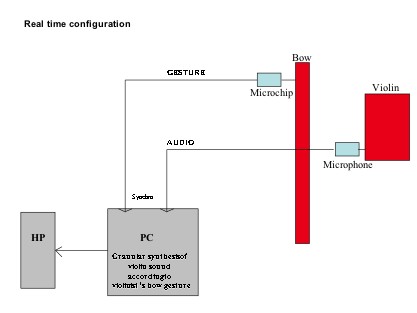
The BogenLied MaxMsp patch (written by Serge Lemouton)
The BogenLied MaxMsp patch contains 2 granular synthesis modules and several effects.
The first granulator is used to produce drones (pedal-notes). The "détaché" section (Section 2) is based on a G, the "martelé" (section 4) on a A and the spiccato section (section 6) an a E.
The second granular synthesis is used for real-time processing of the live violin sound. The signal captured by the microphone is recorded in a 5 second circular buffer~, 100 to 200 ms grains are played from this buffer. The grain density (number of grains playing simultaneously) is controlled by the gesture "intensity" (see below, paragraph ?) in section 2 and 6. In section 4, the gesture intensity is controlling the spread of grain transposition (the sound of small gestures is not transposed, but with strong gestures all the grains are randomly transposed around the played pitch). The granular synthesis are processed through several classical effects : frequency-shifter, harmonizer, filter and vocoder. Each section is characterised by the use of different combinations and parametrizations of these effects. Finally the electronic sound is sent to a "Spatialisateur" to be rendered by a hexaphonic sound diffusion system.
Gesture Mappings:
The signal coming from the gesture sensors and the analysis of this signal are mapped to the sound processing patch using the three following different modalities :
a) quantitative mapping : The gesture intensity controls continuously the density or the transposition of the real-time granulator.
b) discrete selection : In the last part of BogenLied, the bow-stroke recognition is used to choose the transformation corresponding to the played articulation. In this section, a detaché note triggers the transformation used in section 2, a martelé recalls the effects of section 4 and a spiccato recalls the presets of section 6. The three bowings appear successively, together with their own compositional material. The related electro-acoustic treatment is driven by the by recognition system.
c) qualitative mapping : At the end of the score (part IX), the performer plays hybrid bow strokes as a mutation from an articulation to another one. The system use the computed weights for each bowstroke to control the level of the pivot-note associated with each articulation. For instance, a bow-stroke between martelé and detaché will be reported by the knn method with the proportion (50%, 50%, 0%) and, consequently, accompanied by the musical interval G - A, and so on. Every bow-stroke is coloured by a combinaison of this 3 pitches reflecting continuously the quality of the articulation. With this very clear audio feedback indication, the player can really interact with his/her electronic accompaniment using a subtle bow control and the listener can understand the relation between the played articulation and the sonic result.
Detailed technical requirements (sound, light, stage area, etc.)
Equipment brought by Ircam :
1 Powerbook G4
2 Interfaces audio RME Multiface
wireless Gesture Interface. To place close to the performer.
Augmented violin bow (bow + sensors)
1 violin mike (DPA)
Hub ethernet
Ethernet Cables
Additional Equipment needed :
Mixing desk (Yamaha 02R or DM20009 + table + power supply
Ethernet cable (RJ45) from scene to computer
2 lines from scene to computer
1 mike for violin amplification
Hexaphonic sound diffusion system
1 stage monitor
(Plus d'infos, voir le catalogue) I (Détail de la partition) I (écoute) I
(Retour haut de page)